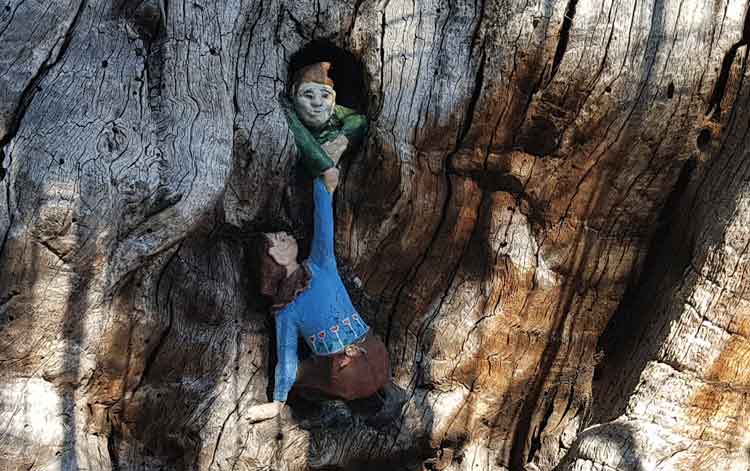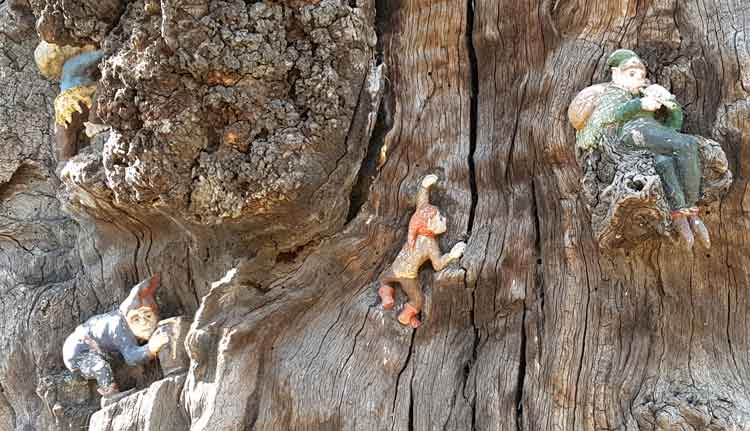
Have you been to see the giant Griglan in Kensington Gardens? Were you actually aware that there was a giant Griglan in Kensington Gardens. Do you even know what a Griglan is?
Me neither.
Until, that is, I discovered the Elfin Tree, the gnarled trunk of an old oak that can be found next to the Princess Diana Children's Playground in Kensington Gardens.
Suddenly, I found myself transported into a magical realm, inhabited by an assortment of elves, fairies, goblins, witches and miniature animals and birds.
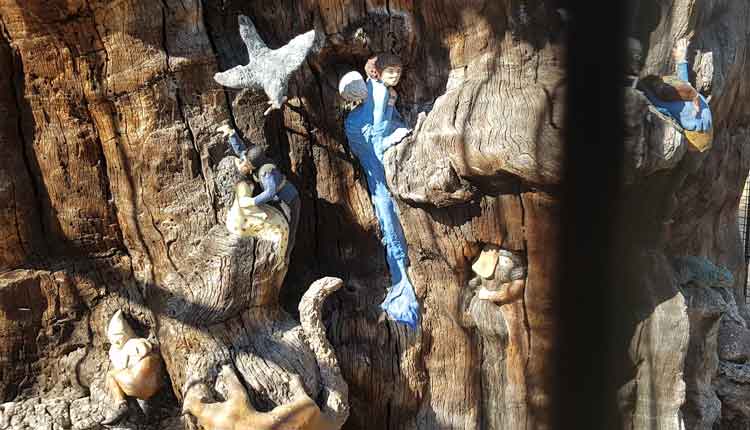
The Elfin Oak, you see, is a sculpture that was created between 1928 and 1930 by the Scottish artist Ivor Innes, who carved 74 miniature figures around the natural features of the hollow trunk of an 800-year-old oak tree, which had been brought specifically for the purpose to Kensington Gardens from Richmond Park.
Nowadays, the tree looks a little incongruous, imprisoned as it is within an iron cage; a necessary precaution intended to either stop the magical creatures within from escaping back to fairyland, or, more probably, to prevent the non-magical creatures without from making off with some of the figures.
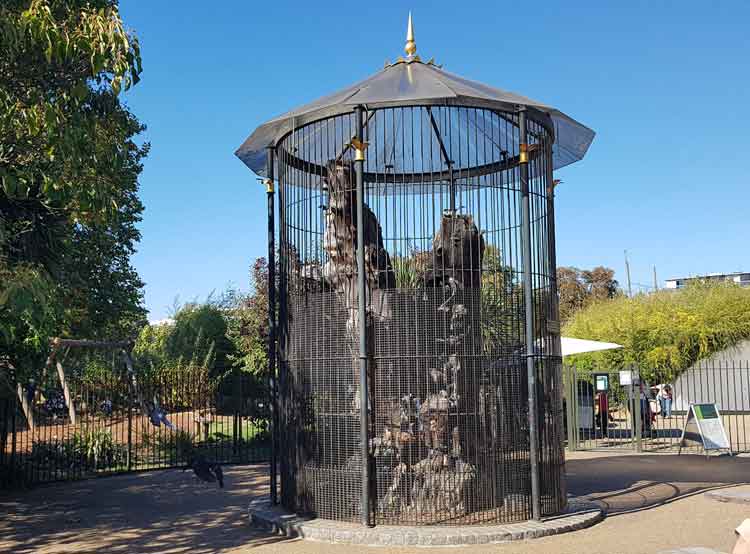
The idea of bringing the old oak from Richmond to Kensington came from Labour politician George Lansbury (1859 - 1940) - father of Hollywood actress Dame Angela Lansbury - who (George not Angela) was at the time head of the Office of Works.
Lansbury had been introduced to Ivor Innes by Winifred Fortescue, and he was sufficiently impressed by Innes's work to invite him to contribute to his scheme of public improvements for London.
When it was revealed that the tree was to become a haven for the wee folk, the press dubbed it "Uncle George's Gnomeland."
As the Graphic put it, on Saturday, 26th July 1930:-
"The new addition to Uncle George Lansbury's brighter Kensington Gardens is a massive old oak trunk, 20 feet in girth, which a Scottish artist, with a fine gift of Celtic imagination, has carved into numerous figures of fairy land..."
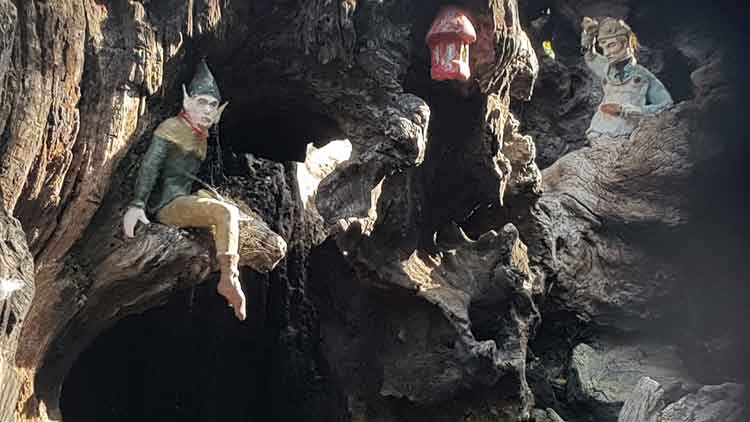
The tree was unveiled by the wife of the Mayor of Kensington, on Friday, 25th July 1930, and The Western Morning News, in its next day's edition, provided a description of the creative process employed by Mr. Innes, whilst also revealing exactly what a Griglan was:-
"Cornwall contributed in a roundabout way to the curious "elfin tree" which the Mayoress of Kensington unveiled in the children's playground in Kensington Gardens.
This is the trunk of a very old pollarded oak removed from Richmond Park, and on it Mr. Ivor Innes, the artist, has carved a population of elves and animals.
Mr. Innes's method is peculiar. He takes the shapes and forms already on his tree trunk and then carves out what they suggest to him, be it elf or owl or rabbit, the carvings are then coloured by a secret process of his own.
Mr. Innes calls his art "Griglans", which, as the knowledgeable Cornishman will be aware, is the Cornish dialect word for heather or ling.
The idea first came into Mr. Innes's head from the curious shape of a gnarled, twisted, heather stem which he once picked up on the Cornish coast and on which he first exercised his art.
The strictly honest art critic will not perhaps approve of the "elfin tree," which may seem too akin in sentiment to the base of Sir George Frampton's statue of Peter Pan. Certainly these figures by Mr. Innes, clever as they are, seem a little incongruous on a sturdy old oak, but I have no doubt at all that the many children who throng the playground will find them a source of unending delight."
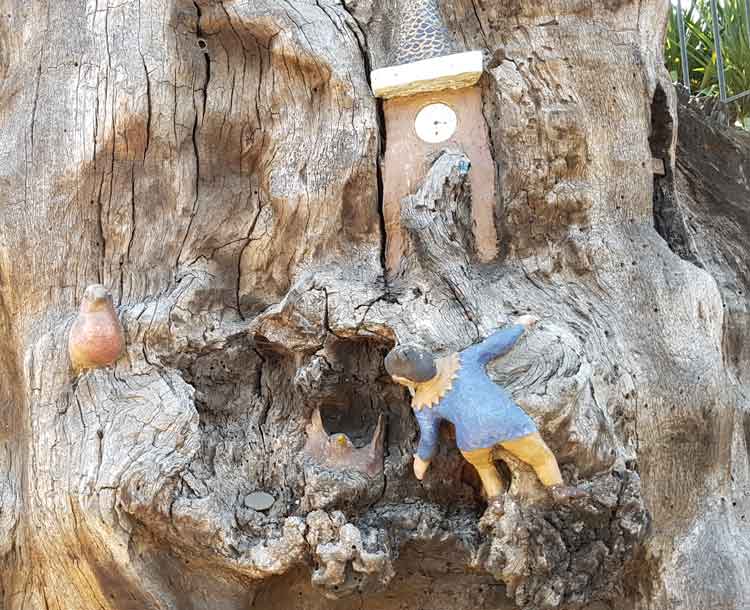
The tree soon became a popular attraction, and hundreds of people flocked to Kensington Gardens to admire it every week.
On Tuesday, 2nd December 1930, The Aberdeen Press and Journal published the following article, by Ivor Innes himself, in which he spoke of how he first became fascinated by Griglans:-
"Griglans! What are Griglans?" This query is sure to be made by those who see this name for the first time, so I will explain.
Griglans are pieces of heather root turned by me into decorative and useful articles for the home, such as ornaments, candlesticks, electric table lamps, and fruit dishes. They make especially appealing and novel decorations for the table.
The Elfin Oak in Kensington Gardens might be called a giant Griglan. It is carried out in the same spirit and the same manner. But in this case a sturdy oak trunk takes the place of the heather roots and there are seventy-four little people and animals instead of perhaps, two, three, or four.
"Griglan" is the Celtic word for heather root. I chose it to describe my pieces because it has just that suggestion of mystery that makes it intriguing.
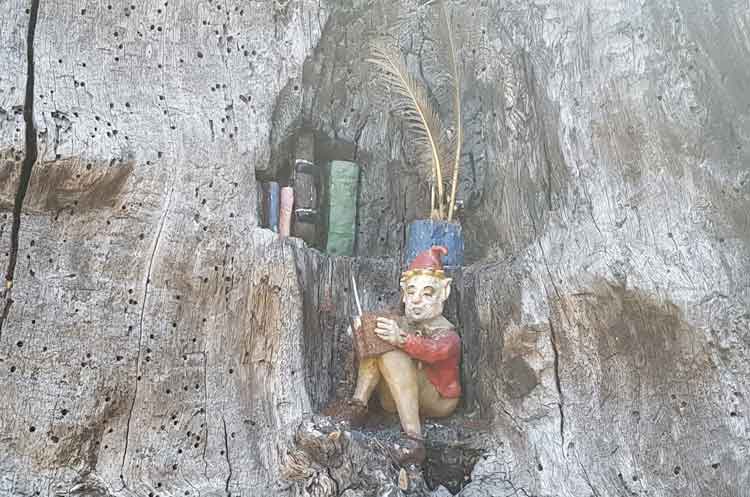
THE FIRST GRIGLANS
The birth of the Griglans was due entirely to an accident.
One summer day after painting for hours in the broiling sun on the Cornish coast, I caught sight of a limpid, cool, inviting pool far down on the rocks below. With both hands full of my painting paraphernalia I started to scramble down the cliff side.
Suddenly I went sprawling. Everything I carried was scattered far and wide. I found my finished painting downwards on the ground, and so smeared that it was just a meaningless mass of colour. All my work wasted!
The cause of my disaster was a twisted heather root! "That shan't happen again", I said as I viciously pulled up the root. I was just about to hurl it into space when I saw a face looking at me. A queer face it was, with two large ears, and attached to it an indefinite sort of body that ended in a funny squiggly tail.
GRIMJAWL
The thing fascinated me. I carried it with me to the pool. While sitting I idly touched it here and there with the colours left on my palette. The fascination grew. I took it to our camp to show my wife. She was delighted.
We hung the quaint little fellow outside our tent as a mascot and christened him "Grimjawl."
That was the beginning of the "Griglans." I began to search for roots in which I could trace whimsical phantastical or realistic figures.
My greatest ambition is to for the children of my native Scotland what I have done for London children. I want to see an Elfin Oak placed somewhere in Edinburgh. Scotland cannot produce an oak of anything like the girth of the one in Kensington Gardens, which had been growing in Richmond Park for 800 years.
Someday, transport problems may be overcome, and we shall be able to send a worthy oak to Edinburgh from this country.
Then I hope to spend as happy a five months as I did when I worked on the Elfin Oak in Kensington Gardens conjuring up a fairyland for the children."
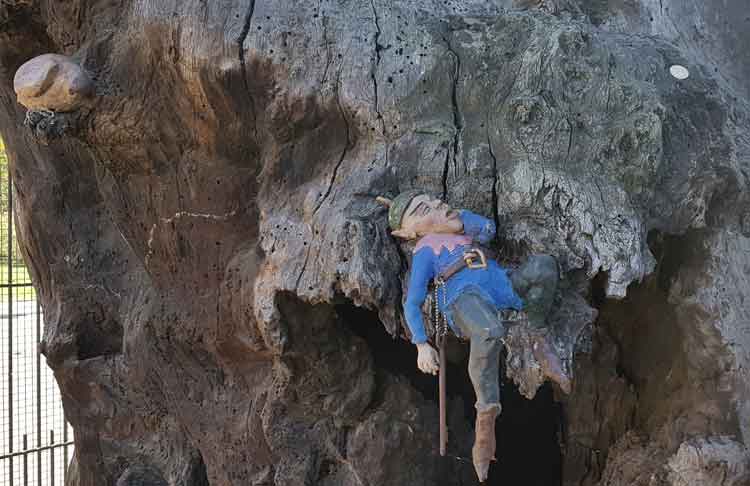
However, time and the elements did not deal kindly with the Elfin Oak, and by the 1950s it was in a sad and sorry state.
The Birmingham Daily Post reported on its restoration on Thursday, 20th June 1957:-
"The Elfin Oak is being restored by the Ministry of Works.
It is a large pollarded oak bole, nearly twenty feet in diameter, covered with carved gnomes, pixies, fairies and animals all of them brightly coloured.
It stands in Kensington Gardens, and is a great attraction for children.
George Lansbury was responsible for the introduction of this strange object into the park.
He had been introduced to Ivor Innes, a Cornish artist, by Lady Fortescue, wife of the military historian, and asked him to produce some of his carvings "out of " the tree bole."
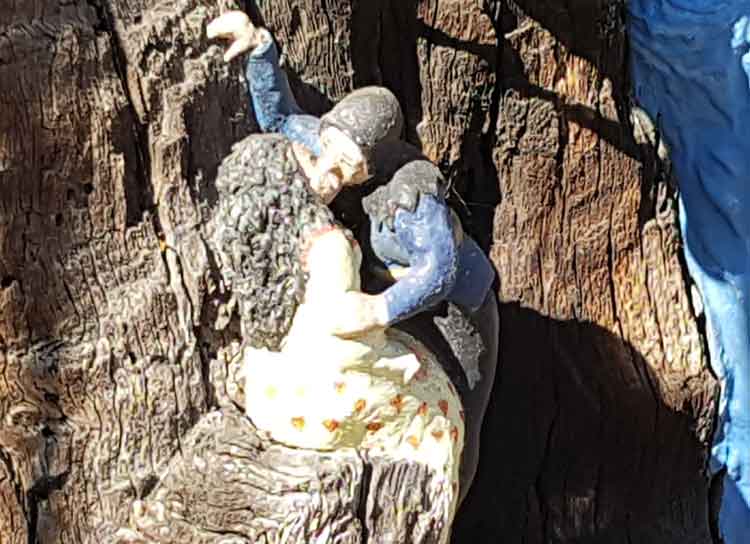
By 1964, the tree was again in need of some TLC. This time its rescuer was the comedian Spike Milligan (1918 - 2002) who lived nearby, and whose daughter, Laura, had told him that it was a pity that the tree needed mending.
Milligan set about devoting his weekends to restoring the tree, funding the project from his own resources.
It took him two years to complete the task, and, by the end of September 1966, the tree was once more on view, much to the delight of children and adults alike.
The Tatler applauded the service Spike had performed for the local community in its edition of Saturday, 24th September 1966:-
"When Spike Milligan showed an interest the tree desperately needed repairs and renovations. Now his work is over - and the tree is again on view as an attractive curiosity."
In 1969, Pink Floyd's lead singer, David Gilmour, was photographed standing in front of the Elfin Oak for the inside cover of their fourth album "Ummagumma".
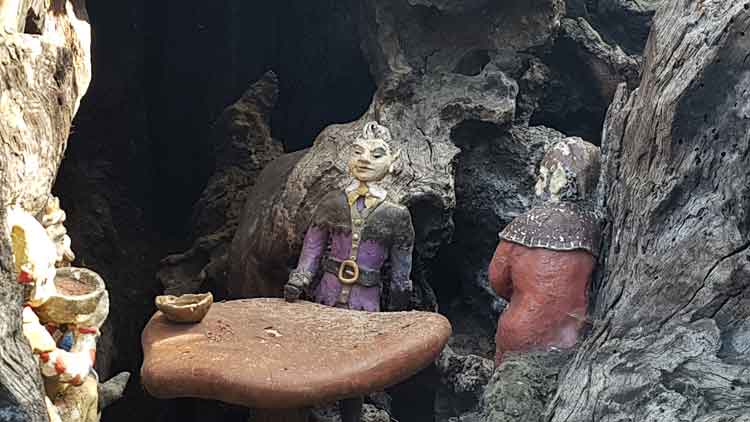
By 1996, constant exposure to wind, rain and pollution had taken its toll, and the tree was again in need of repair and restoration.
Once more, Spike Milligan came to its rescue, and set about raising the £100,000 that was needed to enable students from the Byam School of Art, in Holloway - under the direction of the artist and conservator Marcus Richards - to treat the timber in order to prevent further decay, before remodelling and re-painting the figures.
"Alas, the tree is now in a sorry state," Spike Milligan told The Kensington Post, "and it needs attention to ensure its permanent survival."
The work took a year to complete, and, in June, 1997, the newly restored Elfin Oak was unveiled by Prince Charles.
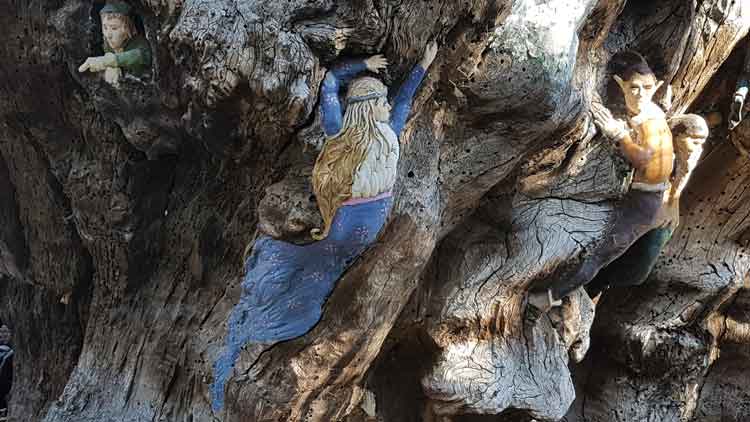
In December, 1997, it was announced that the Elfin Tree was to be given listed status.
On 19th December, 1997, The Department of Culture, Media and Sport, put out the following delightfully whimsical press release to announce the decision:-
"The Little People will have particular cause for revelry and frolicking in Kensington Gardens tonight.
Wookey the witch, Huckleberry the gnome and Grumples and Groodle the elves, have today become the proud inhabitants of one of England's most unusual listed buildings.
The Elfin Oak of Kensington Gardens has been added to the list of buildings of special architectural or historic interest following a recommendation from English Heritage. It has been listed in Grade II.
Announcing the listing of the Oak, Heritage Minister Tony Banks said:-
"The Elfin Oak is a wonderful curiosity, loved by Londoners and visitors alike. It also has considerable historic interest. Sculpted by children's book illustrator Ivor Innes, between 1928 and 1930, the Oak belongs firmly to the late Victorian interest in Little People which culminated in J M Barrie's Peter Pan.
The Oak complements the statue of Peter Pan by Sir George Frampton, which Barrie erected in 1912.
Together, the two sculptures make Kensington Gardens very much the world capital of fairies, gnomes and elves."
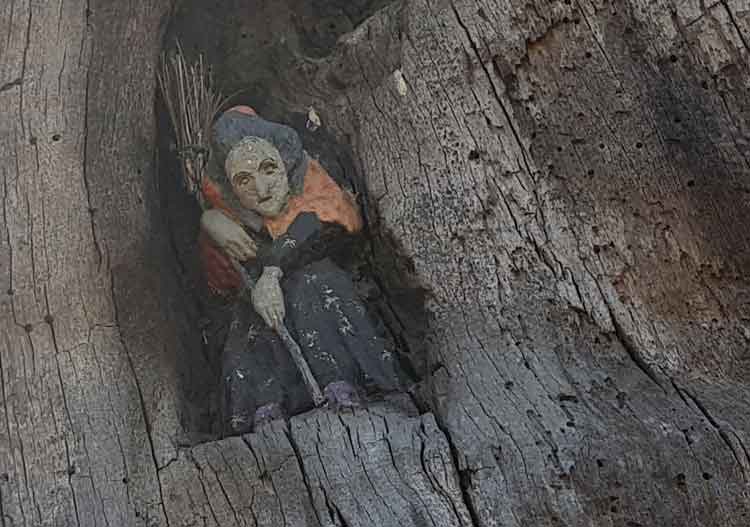
Today, the tree sits alongside the Princess Diana Children's Playground and doesn't garner the attention that it did in the past, albeit those who take the trouble to visit it almost always come away absolutely delighted.
Marcus Richards continues to be responsible for maintaining it, and a sturdy iron cage keeps it safe from the light-fingered attentions of over-enthusiastic souvenir hunters.
It is a special and magical attraction - eccentric, whimsical and delightfully cute - and is well worth paying a visit to.
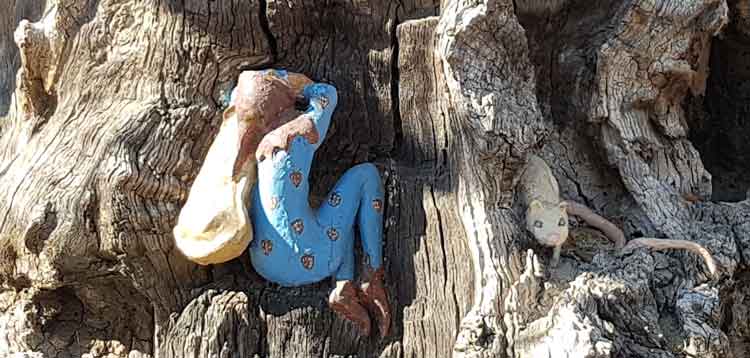
But the last word should go to Elsie Innes, wife of Ivor, who, in 1930, published the book The Elfin Tree, which was based on this venerable old oak, about which she wrote:-
"...for centuries now it has been the home of fairies, gnomes, elves, imps, and pixies. In the nooks and crannies they lurk, or peer out of holes and crevices, their natural windows and doorways. It is their hiding-place by day, their revelry place by night, and when the great moon tops the bare branchless tree the Elfin Clans come out to play and frolic in the moonlight."
And long may they continue to frolic!
